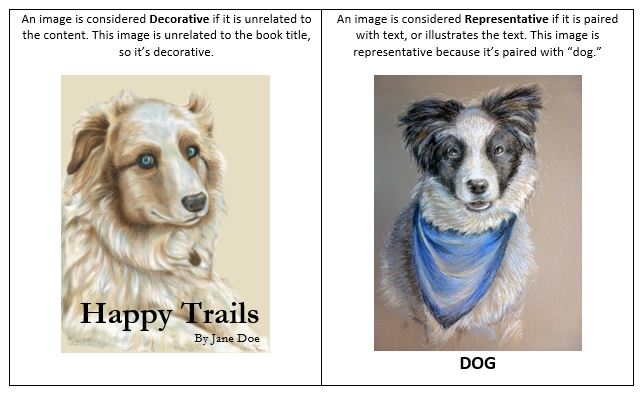Using Images in Online Courses
College of Education
SUMMARY: As you begin preparing your Canvas courses for the spring semester, consider the many ways you could be using images to engage learners, make your courses more interesting, and increase student learning.
Using images in online courses by Dr. Diane Wilcox
As you begin preparing your Canvas courses for the spring semester, consider the many ways you could be using images to engage learners, make your courses more interesting, and increase student learning. Did you know that images have different communication functions and that certain kinds of images are more effective in promoting higher-order thinking skills? Consider this…
|
Decorative Image |
Most faculty members use decorative images in their course materials. Decorative images are images that have aesthetic appeal only – like borders used on slides and images that are unrelated to the content. While these images may make your instructional materials look good, research shows that they have little effect on learning, and can even be confusing to learners.
|
Representative Image |
On the other hand, research shows that representative images - images that duplicate text-based information – actually have a moderate effect on learning. Representative images are especially useful in teaching new concepts, facts, and processes because they show in images the information you are trying to convey in words.
Research shows that explanatory images have an even greater effect on learning than representative images because they help explain and interpret content for the learner. These images are divided into sub categories according to their specific communication function. Relational images, such as pie charts and bar charts, show quantitative comparisons. Organizational images demonstrate qualitative relationships among content. Concept maps and site maps are good examples of organizational images. Transformational images illustrate change over time or space. An animation that shows how fractions are made when a pizza is cut into 4 equal pieces is an example of transformational image. Finally, interpretive images help learners better understand abstract or underlying processes. An illustration that shows how blood flows through the heart is an example of an interpretive image.
Mnemonic images support cognitive processes by creating visual analogies that enable learners to consider the content in a new way and then link the newly considered content to information they already know. These images are challenging to create and use across different cultures because their meaning is often culture specific.
Regardless of the image’s communication function, it’s important to remember that simple, iconic, high contrast images are often most effective in instructional applications, as they minimize cognitive load and focus the learners’ attention on the most important information in the visuals. When creating online course materials, make sure you use visual design principles to manage cognitive load, such as chunking of information, white space, judicious use of color, contrast, repetition, alignment, and proximity. Use a hierarchical page layout and place the most important information at the top of the page.
As you are designing your courses for online use, remember that accessibility matters. All of your images should be high contrast to ensure they can be seen by those with visual impairment. Also, it’s best to use simple images that are gender and culture neutral to ensure the images are meaningful to a wide audience. Finally, all images should be tagged with alternative text to ensure they are accessible to everyone using the content.
JMU Libraries provides links to a number of free image resources, from stock photos to vector images. Newly added image collections include Nappy, which offers free, high-resolution images of black and brown people, and The Gender Spectrum Collection, which offers stock photos of trans and non-binary models. You can find these resources at https://guides.lib.jmu.edu/freemedia/image.


